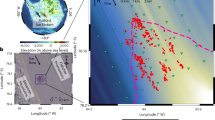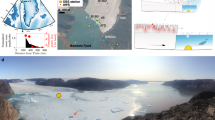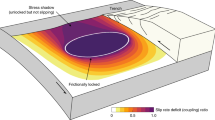Abstract
Long-period seismic sources associated with glacier motion have been recently discovered1,2, and an increase in ice flow over the past decade has been suggested on the basis of secular changes in such measurements3. Their significance, however, remains uncertain, as a relationship to ice flow has not been confirmed by direct observation. Here we combine long-period surface-wave observations with simultaneous Global Positioning System measurements of ice displacement to study the tidally modulated stick–slip motion of the Whillans Ice Stream in West Antarctica4,5. The seismic origin time corresponds to slip nucleation at a region of the bed of the Whillans Ice Stream that is likely stronger than in surrounding regions and, thus, acts like an ‘asperity’ in traditional fault models. In addition to the initial pulse, two seismic arrivals occurring 10–23 minutes later represent stopping phases as the slip terminates at the ice stream edge and the grounding line. Seismic amplitude and average rupture velocity are correlated with tidal amplitude for the different slip events during the spring-to-neap tidal cycle. Although the total seismic moment calculated from ice rigidity, slip displacement, and rupture area is equivalent to an earthquake of moment magnitude seven (Mw 7), seismic amplitudes are modest (Ms 3.6–4.2), owing to the source duration of 20–30 minutes. Seismic radiation from ice movement is proportional to the derivative of the moment rate function at periods of 25–100 seconds and very long-period radiation is not detected, owing to the source geometry. Long-period seismic waves are thus useful for detecting and studying sudden ice movements but are insensitive to the total amount of slip.
This is a preview of subscription content, access via your institution
Access options
Subscribe to this journal
Receive 51 print issues and online access
$199.00 per year
only $3.90 per issue
Buy this article
- Purchase on Springer Link
- Instant access to full article PDF
Prices may be subject to local taxes which are calculated during checkout




Similar content being viewed by others
References
Ekstrom, G., Nettles, M. & Abers, G. A. Glacial earthquakes. Science 302, 622–624 (2003)
Tsai, V. C. & Ekstrom, G. Analysis of glacial earthquakes. J. Geophys. Res. 112, 10.1029/2006JF000596 (2007)
Ekstrom, G., Nettles, M. & Tsai, V. C. Seasonality and increasing frequency of Greenland glacial earthquakes. Science 311, 1756–1758 (2006)
Bindschadler, R. A., King, M. A., Alley, R. B., Anandakrishnan, S. & Padman, L. Tidally controlled stick-slip discharge of a West Antarctic Ice Stream. Science 301, 1087–1089 (2003)
Bindschadler, R. A., Vornberger, P. L., King, M. A. & Padman, L. Tidally driven stick-slip motion in the month of Whillans Ice Stream, Antarctica. Ann. Glaciol. 36, 263–272 (2003)
Bindschadler, R. A. & Bentley, C. R. On thin ice? Sci. Am. 287, 98–105 (2002)
de Angelis, H. & Skvarca, P. Glacier surge after ice shelf collapse. Science 299, 1560–1562 (2003)
Scambos, T., Bohlander, J., Shuman, C. & Skvarca, P. Glacier acceleration and thinning after ice shelf collapse in the Larsen B embayment, Antarctica. Geophys. Res. Lett. 31 10.1029/2004GL020670 (2004)
Fischer, U. H. & Clarke, G. K. C. Stick-slip sliding behaviour at the base of a glacier. Ann. Glaciol. 24, 390–396 (1997)
Aki, K. Generation and propagation of G waves from the Niigata earthquake of June 16, 1964. Part 2. Estimation of earthquake moment, released energy, and stress-strain drop from the G-wave spectrum. Bull. Earthq. Res. Inst., Tokyo Univ. 44, 73–88 (1966)
Wiens, D. A., Anandakrishnan, S., Nyblade, A. & Aleqabi, G. Remote detection and monitoring of glacial slip from Whillans Ice Stream using seismic Rayleigh waves recorded by the TAMSEIS array. Eos 87, abstr.–S44A-04 (2006)
Joughin, I. et al. Continued deceleration of Whillans Ice Stream, West Antarctica. Geophys. Res. Lett. 32 10.1029/2005GL024319 (2005)
Bindschadler, R. A., Stephenson, S. N., MacAyeal, D. R. & Shabtaie, S. Ice dynamics at the mouth of Ice Stream B, Antarctica. J. Geophys. Res. 92, 8885–8894 (1987)
Alley, R. B. In search of ice-stream sticky spots. J. Glaciol. 39, 447–454 (1993)
Peters, M. E., Blankenship, D. D. & Morse, D. L. Analysis techniques for coherent airborne radar sounding: Application to West Antarctic ice streams. J. Geophys. Res. 110 10.1029/2004JB003222 (2005)
Das, S. & Aki, K. Fault planes with barriers: A versatile earthquake model. J. Geophys. Res. 82, 5648–5670 (1977)
Lay, T. & Kanamori, H. in Earthquake Prediction: An International Review (eds Simpson, D. W. & Richards, P. G.) 579–592 (American Geophysical Union, Washington DC, 1981)
Anandakrishnan, S., Voigt, D. E., Alley, R. B. & King, M. A. Ice stream D flow speed is strongly modulated by the tide beneath the Ross Ice Shelf. Geophys. Res. Lett. 30 10.1029/2002GL016329 (2003)
Russell, D. R. Development of a time-domain, variable-period surface-wave magnitude measurement procedure for application at regional and teleseismic distances. Bull. Seismol. Soc. Am. 96, 665–677 (2006)
Beroza, G. C. & Jordan, T. H. Searching for slow and silent earthquakes using free oscillations. J. Geophys. Res. 95, 2485–2510 (1990)
Rhie, J. & Romanowicz, B. Excitation of the Earth's continuous free oscillations by atmosphere-ocean-seafloor coupling. Nature 431, 552–556 (2004)
Kanamori, H. & Given, J. W. Use of long-period surface waves for rapid determination of earthquake source parameters. Phys. Earth Planet. Inter. 27, 8–31 (1981)
Suda, N., Kazunari, K. & Fukao, Y. Earth's background free oscillations. Science 279, 2089–2091 (1998)
Horgan, H. J. & Anandakrishnan, S. Static grounding lines and dynamic ice streams: Evidence from the Siple Coast, West Antarctica. Geophys. Res. Lett. 33 10.1029/2006GL027091 (2006)
Padman, L., Fricker, H. A., Coleman, R., Howard, S. L. & Erofeeva, S. A new tidal model for the Antarctic ice shelves and seas. Ann. Glaciol. 34, 247–254 (2002)
Zumberge, J. F., Heflin, M. B., Jefferson, D. C., Watkins, M. M. & Webb, F. H. Precise point positioning for the efficient and robust analysis of GPS data from large networks. J. Geophys. Res. 102, 5005–5017 (1997)
Chen, G. GPS Kinematics Positioning for the Airborne Laser Altimetry at Long Valley, California. PhD thesis, Massachusetts Institute of Technology (1998)
Dow, J. M., Neilan, R. E. & Gendt, G. The international GPS service: celebrating the 10th anniversary and looking to the next decade. Adv. Space Res. 36, 320–326 (2005)
Eissler, H. K. & Kanamori, H. A single-force model for the 1975 Kalapana, Hawaii, earthquake. J. Geophys. Res. 92, 4827–4836 (1987)
Kawakatsu, H. Centroid single force inversion of seismic waves generated by landslides. J. Geophys. Res. 94, 12363–12374 (1989)
Dahlen, F. A. Single-force representation of shallow landslide sources. Bull. Seismol. Soc. Am. 83, 130–143 (1993)
Anandakrishnan, S. & Winberry, J. P. Antarctic subglacial sedimentary layer thickness from receiver function analysis. Global Planet. Change 42, 167–176 (2004)
Kennett, B. L. N. Seismic Wave Propagation in Stratified Media (Cambridge Univ. Press, Cambridge, UK, 1983)
Lawrence, J. F. et al. Rayleigh wave phase velocity analysis of the Ross Sea, Transantarctic Mountains, and East Antarctica from a temporary seismic deployment. J. Geophys. Res. 111 10.1029/2005GL024523 (2006)
Acknowledgements
GPS receivers for the TIDES project were supplied by the University NAVSTAR Consortium. Seismic data were obtained from the Data Management Center of the Incorporated Research Institutions for Seismology. This research was funded by the Office of Polar Programs, US National Science Foundation. M.A.K. was partially funded by a NERC (UK) research fellowship. We thank R. B. Alley, R. A. Bindschadler, H. Horgan, I. Joughin, L. Peters and D. E. Voigt for planning and carrying out the TIDES field deployment.
Author Contributions D.A.W. found the ice slip signals on the seismic records and carried out the seismic processing and modelling. D.A.W. also filtered the GPS time series and calculated the slip nucleation locations and times from the GPS records. S.A. and J.P.W. carried out the GPS fieldwork and calculated the displacement time series from the three-dimensional GPS data. M.A.K. processed the raw GPS data to obtain the three-dimensional displacement time series. All authors participated in the interpretation of the results and preparing the paper.
Author information
Authors and Affiliations
Corresponding author
Supplementary information
Supplementary information
The file contains Supplementary Tables 1-2. (PDF 58 kb)
Rights and permissions
About this article
Cite this article
Wiens, D., Anandakrishnan, S., Winberry, J. et al. Simultaneous teleseismic and geodetic observations of the stick–slip motion of an Antarctic ice stream. Nature 453, 770–774 (2008). https://doi.org/10.1038/nature06990
Received:
Accepted:
Issue Date:
DOI: https://doi.org/10.1038/nature06990
This article is cited by
-
Highly variable friction and slip observed at Antarctic ice stream bed
Nature Geoscience (2023)
-
Changing friction at the base of an Alpine glacier
Scientific Reports (2021)
-
Ocean-bottom and surface seismometers reveal continuous glacial tremor and slip
Nature Communications (2021)
-
Surface melt driven summer diurnal and winter multi-day stick-slip motion and till sedimentology
Nature Communications (2019)
-
Motion of an Antarctic glacier by repeated tidally modulated earthquakes
Nature Geoscience (2012)
Comments
By submitting a comment you agree to abide by our Terms and Community Guidelines. If you find something abusive or that does not comply with our terms or guidelines please flag it as inappropriate.



